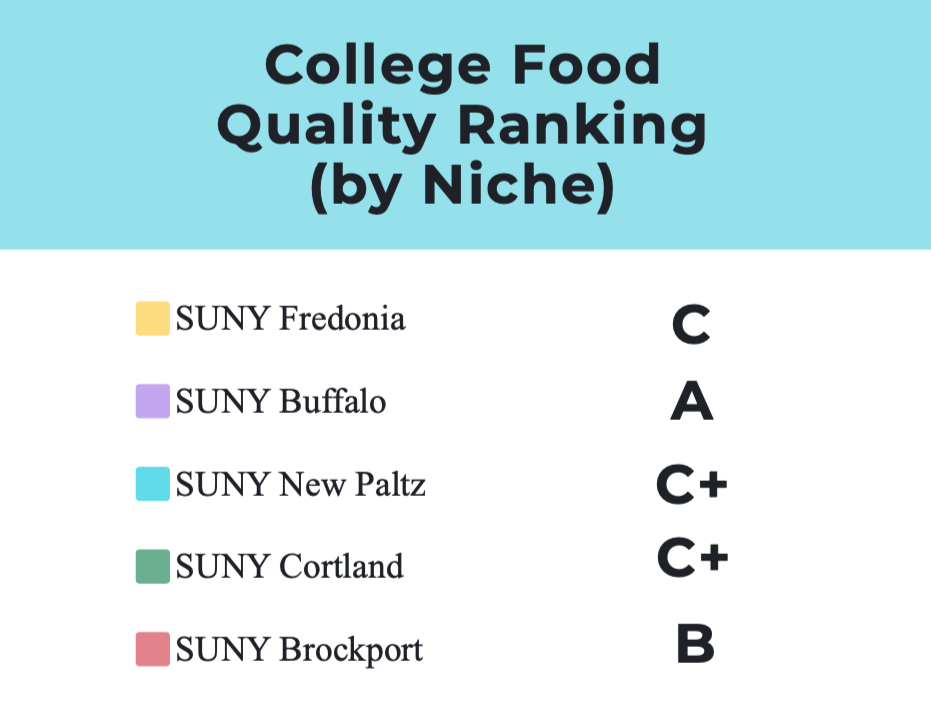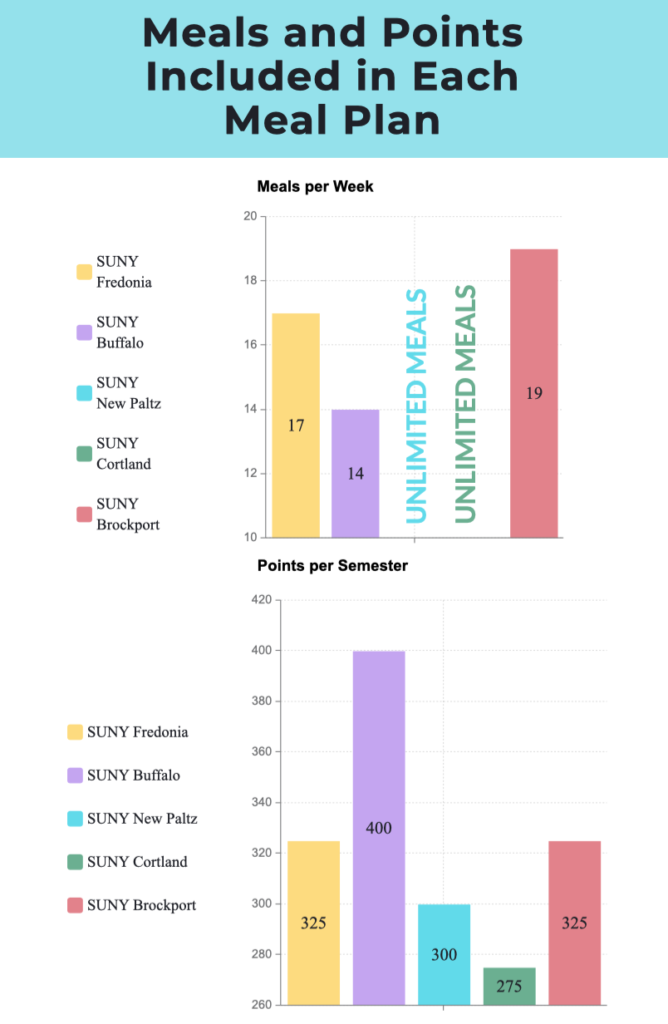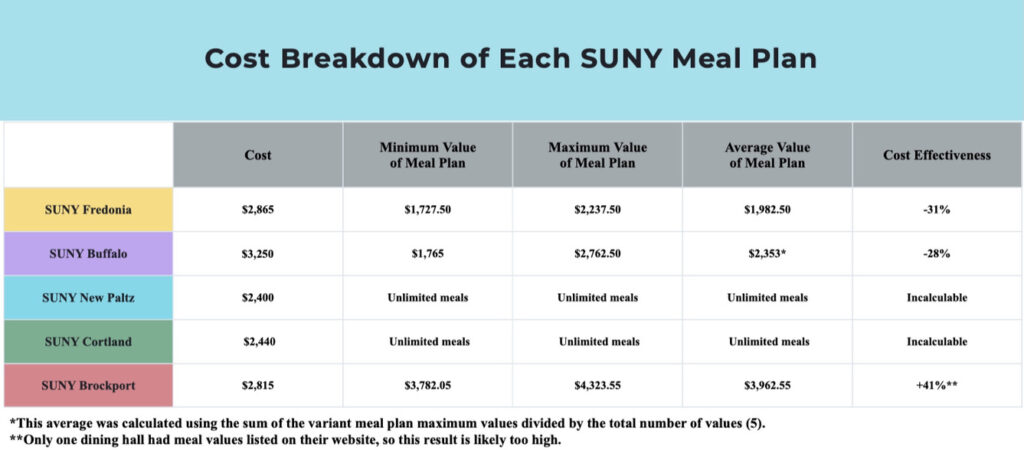CASEY HUBER
Special to The Leader
How would you rate the on-campus food out of 10?
“6. It’s fine,” one student said.
“6,” another student said.
“6.5. The lack of options makes having any dietary restriction difficult,” another student said.
“5. I wish they put more time and love and effort into the food,” another student said.
These student reviews mirror the score assigned by college ranking organization Niche, which scored SUNY Fredonia at a middling C.
How the system works
At Fredonia, there are two predominant food money types: “meals” and “points.”
Meals are a bit complicated. The actual value of a meal swipe is different depending on where you go to eat.
At Cranston Marché, one meal swipe is equivalent to $11 at dinner time. This means that you could pay either in one meal swipe, or in currency such as cash or credit card.
However, at Starbucks a meal is $5.50, therefore your meal swipe is worth a lesser amount of money.
Points are much simpler. They are equal to the amount of money, in cash, you put into them. If you decide to add 300 points to your card, it costs about $300.
The problems with the system
Let’s hear some student perspectives on the meal plan systems and Fredonia’s food distribution in general.
“I feel like they should have more of a variety of options to choose from,” Fredonia student Amarah Gori said.
Gori went on to say that she would expect that the number of meals per week would be 21, or three meals per day. She also commented that more eateries on campus would be beneficial.
Other students have similar perspectives that the food quality is lacking and that the food distribution system needs revamping.
“The only food [on campus] I enjoy eating are Starbucks and Tim Horton’s,” Fredonia student Karie Hawkins said. It is important to note that both Starbucks and Tim Horton’s are franchise restaurants and are therefore not directly run by the Faculty Student Association (FSA). “I think it’s kind of unfair that people that have the all-points meal plan can only spend 50 points a day. People that have the all-points meal plan should have at least 100 points per day.”
Some students try to circumvent the problems by avoiding cooked food altogether.
“I try to stay away from things that are cooked at Willies,” Fredonia junior Rachel Mayou said.
“I usually go to the C-Store for lunch, and occasionally after practice I can go to Cranston.”
When asked about how the meal system worked for her, Mayou felt there were too few meals.
“For an athlete, I think it’s absolutely ridiculous. I think you get 17 meals [in Plan 1, which is required for first semester, on-campus freshman] which isn’t three meals a day for a week. I would run out of meals halfway through the week because I was swimming, and you eat a lot of food for swimming.”
What other SUNY colleges are doing
To better understand whether SUNY Fredonia is doing things as best as it can, we should compare and contrast with other SUNY schools.
The question: Can I find a default meal plan for freshmen that is both cost effective and flexible?
The methodology: Take several SUNY schools at random and compare their introductory meal plan systems.
The selection: I used SUNY Fredonia, SUNY Buffalo (UB), SUNY New Paltz and SUNY Cortland to compare and contrast. Note that UB is significantly larger than the rest of these schools with close to 30,000 students. This will be elaborated further in the results section.
Before we get into the table below, allow me a moment to preface that I am not a statistician, and the potential for an unfair comparison between two meal plans is possible.
However, I was careful in my methodology to use what is presented as the default, “Plan 1” meal plan and to compare them as such.
The numbers are derived from the campus websites, each reporting what their default meal plan for freshman is, as well as what is included in that meal plan.
Our first comparison is the college food quality ranking by Niche. Here, we see that the schools are pretty close to each other with one exception; SUNY Buffalo (UB) is well above the others.
We will discuss what this exception might mean in the results section below.

These results are from student-polled surveys collected by Niche.
They suggest that, for the most part, SUNY schools are about on the same level in terms of food quality.
This could mean several things.
Smaller schools tend to have less money to spend on things like food preparation or extra staff to manage additional food venues, therefore the smaller schools would have a lower overall quality of food.
However, it is also important to consider the fact that large schools like UB also have to produce much more food than small schools like Fredonia. Therefore, one could argue that the quality of food should be less in the bigger schools.
While the data does not show this phenomenon, our sample size was too small to illustrate a pattern if one were to exist.
Our goal here is to get the students thinking about what you want out of Fredonia’s food.
Next, we will compare and contrast what is included in the default freshman meal plan, namely meals per week and points per semester.

An interesting development here is the unlimited meal plans by SUNY New Paltz and SUNY Cortland. This makes the cost breakdown in the next section a bit more difficult, but for comparison purposes, these are good examples to include.
Once again, our goal with this comparative analysis is to get the students thinking about what they would like to see their money go towards in Fredonia’s food.
Do you want more or fewer meals? Would you use an unlimited meal plan?
Now we get into the nitty-gritty number crunching, so bear with me.
The cost breakdown has five components: cost of the default freshman meal plan, minimum value of that meal plan, maximum value of that meal plan, the average value of the meal plan and the cost effectiveness of buying that meal plan (calculated by dividing the average from the cost).
Note that a negative cost effectiveness suggests that the student would theoretically save money by not buying that meal plan.
However, SUNY campuses, including Fredonia, make the freshman meal plan mandatory for first semester, on-campus students. For many on-campus freshmen, there is no avoiding it.
It is also important to note that the minimum is assuming that students use all of their meal swipes on the lowest value meal equivalency, such as at Starbucks.
The actual average, and therefore the actual cost effectiveness, may be significantly lower if the student doesn’t use all of their meals. This also applies to the maximum.

Interpreting the results
Now that we have these numbers all in front of us, let’s analyze them.
University at Buffalo had the highest overall meal quality according to Niche, but it is important to remember that UB is significantly bigger than most SUNY schools.
The current total enrollment at UB is just short of 30,000, compared to SUNY Fredonia’s almost 4,000 student body.
So what exactly does this mean for UB’s results? Well, one could argue that it skews the results in either direction.
Allow me to explain.
If you consider that the quantity of food being purchased, processed and served to students is significantly higher than at, say, Fredonia, you might be inclined to think that the “A” attributed to food quality is actually much harder to achieve than at a small school like Fredonia.
However, you could also argue on that same point of food quantity that UB would have more money to invest in the food preparation process, therefore their score should be around an “A,” or else they are doing something wrong.
Neither interpretation is necessarily incorrect, both have their merits.
What do you think?
